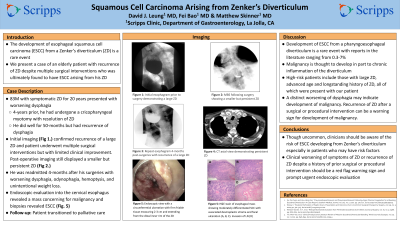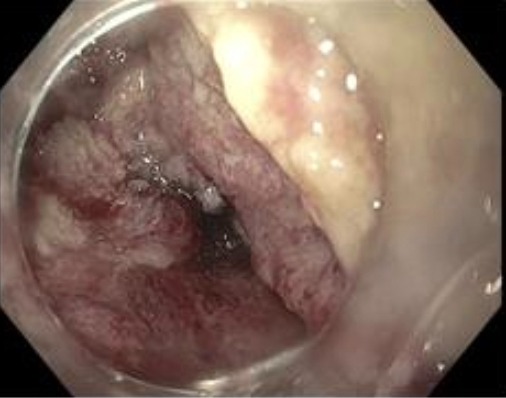Back


Poster Session A - Sunday Afternoon
Category: Esophagus
A0214 - Squamous Cell Carcinoma Arising From Zenker's Diverticulum
Sunday, October 23, 2022
5:00 PM – 7:00 PM ET
Location: Crown Ballroom

Has Audio
.jpg)
David Leung, MD
Scripps Green-Scripps Clinic
La Jolla, CA
Presenting Author(s)
David Leung, MD, Matthew J. Skinner, MD
Scripps Green-Scripps Clinic, La Jolla, CA
Introduction: The development of esophageal squamous cell carcinoma (ESCC) from a Zenker’s diverticulum (ZD) is a rare event. Recurrence of ZD after a surgical or procedural intervention can be a warning sign for development of malignancy. We present a case of an 83-year-old male with 20-year history of symptomatic ZD, who had undergone multiple surgical interventions and ultimately found to have ESCC arising from his ZD.
Case Description/Methods: An 83-year-old male with symptomatic ZD for 20 years presented with worsening dysphagia. 4-years prior, the patient had undergone an endoscopic cricopharyngeal myotomy with resolution of ZD both clinically and on post-operative imaging. He did well for 50-months but had recurrence of dysphagia. Barium esophagram confirmed recurrent ZD. Another cricopharyngeal myotomy was performed. Post-operative modified-barium swallow showed persistent ZD and evidence of significant aspiration. A transcervical diverticulectomy was then performed; however, the surgery was technically difficult and only a partial diverticulectomy was performed. Pathology did not demonstrate SCC. He had limited improvement in symptoms and was readmitted 4-months later with worsening dysphagia, odynophagia, hemoptysis, and unintentional weight loss. A repeat barium esophagram demonstrated a large diverticulum. At this time the gastroenterology service was consulted for for consideration of a peroral endoscopic myotomy of the ZD (Z-POEM). Advancement of the endoscope into the cervical esophagus revealed a circumferential ulceration with firm friable tissue measuring 2-3 cm which extended from the distal rim of the ZD. The mucosa at the base of the ZD pouch was normal. Biopsies revealed invasive, moderately differentiated ESCC. The patient has since been discharged and is undergoing evaluation for continued management.
Discussion: Development of ESCC from a pharyngoesophageal diverticulum is a rare event with reports in the literature ranging from 0.3-7%. Malignancy is thought to develop in part to chronic inflammation of the diverticulum but otherwise the pathogenesis is not well defined. Patients who appear to be at higher risk for development include those with large ZD, advanced age and longstanding history of ZD. A distinct worsening of dysphagia may indicate development of malignancy. Recurrence of ZD in a patient with a history of prior surgical or procedural treatment should also be concerning. Development of such symptoms should prompt urgent investigation.

Disclosures:
David Leung, MD, Matthew J. Skinner, MD. A0214 - Squamous Cell Carcinoma Arising From Zenker's Diverticulum, ACG 2022 Annual Scientific Meeting Abstracts. Charlotte, NC: American College of Gastroenterology.
Scripps Green-Scripps Clinic, La Jolla, CA
Introduction: The development of esophageal squamous cell carcinoma (ESCC) from a Zenker’s diverticulum (ZD) is a rare event. Recurrence of ZD after a surgical or procedural intervention can be a warning sign for development of malignancy. We present a case of an 83-year-old male with 20-year history of symptomatic ZD, who had undergone multiple surgical interventions and ultimately found to have ESCC arising from his ZD.
Case Description/Methods: An 83-year-old male with symptomatic ZD for 20 years presented with worsening dysphagia. 4-years prior, the patient had undergone an endoscopic cricopharyngeal myotomy with resolution of ZD both clinically and on post-operative imaging. He did well for 50-months but had recurrence of dysphagia. Barium esophagram confirmed recurrent ZD. Another cricopharyngeal myotomy was performed. Post-operative modified-barium swallow showed persistent ZD and evidence of significant aspiration. A transcervical diverticulectomy was then performed; however, the surgery was technically difficult and only a partial diverticulectomy was performed. Pathology did not demonstrate SCC. He had limited improvement in symptoms and was readmitted 4-months later with worsening dysphagia, odynophagia, hemoptysis, and unintentional weight loss. A repeat barium esophagram demonstrated a large diverticulum. At this time the gastroenterology service was consulted for for consideration of a peroral endoscopic myotomy of the ZD (Z-POEM). Advancement of the endoscope into the cervical esophagus revealed a circumferential ulceration with firm friable tissue measuring 2-3 cm which extended from the distal rim of the ZD. The mucosa at the base of the ZD pouch was normal. Biopsies revealed invasive, moderately differentiated ESCC. The patient has since been discharged and is undergoing evaluation for continued management.
Discussion: Development of ESCC from a pharyngoesophageal diverticulum is a rare event with reports in the literature ranging from 0.3-7%. Malignancy is thought to develop in part to chronic inflammation of the diverticulum but otherwise the pathogenesis is not well defined. Patients who appear to be at higher risk for development include those with large ZD, advanced age and longstanding history of ZD. A distinct worsening of dysphagia may indicate development of malignancy. Recurrence of ZD in a patient with a history of prior surgical or procedural treatment should also be concerning. Development of such symptoms should prompt urgent investigation.

Figure: Figure 1: Upper endoscopy revealed a circumferential ulceration with firm friable tissue measuring 2-3 cm and extending from the distal inner rim of the ZD.
Disclosures:
David Leung indicated no relevant financial relationships.
Matthew Skinner: Boston Scientific – Consultant.
David Leung, MD, Matthew J. Skinner, MD. A0214 - Squamous Cell Carcinoma Arising From Zenker's Diverticulum, ACG 2022 Annual Scientific Meeting Abstracts. Charlotte, NC: American College of Gastroenterology.
